Why SaaS Lead Generation Companies Are Becoming Data Partners, Not Just Appointment Setters
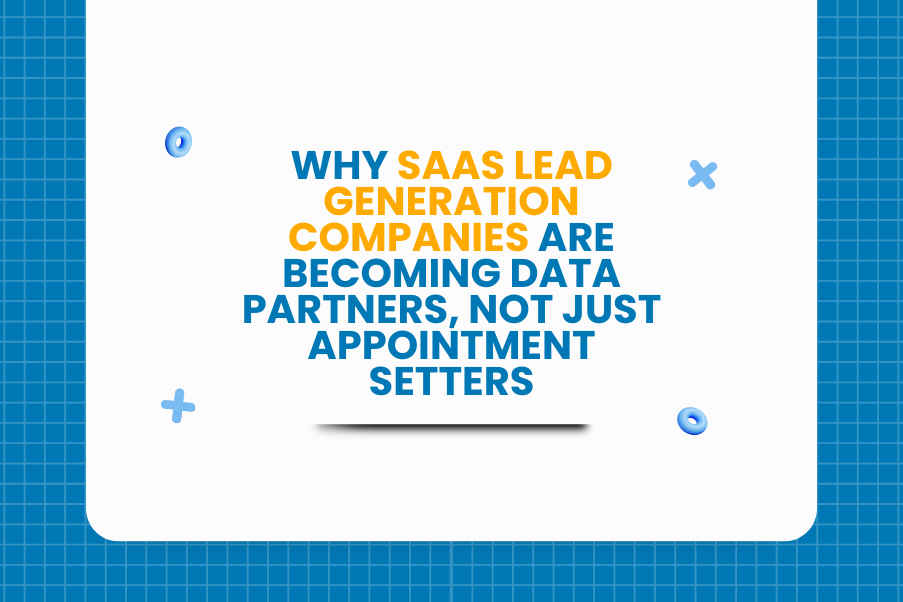
Introduction
For years, the role of a saas lead generation company was limited to booking calls and filling sales calendars. The process was straightforward: provide an ICP, hand over a script, and wait for meetings. However, the SaaS landscape in 2025 demands more. Today, the right saas lead generation company acts as a data partner that informs growth decisions across teams.
Lead generation partners now analyze intent signals, track market trends, enrich databases, and provide predictive insights that feed into sales, marketing, and even product development. For SaaS leaders aiming to optimize CAC and improve LTV, this shift matters. As expectations rise around saas lead generation, companies that invest in intelligence gain a durable edge.
The old paradigm: leads and appointments only
The traditional role of a saas lead generation company revolved around one metric: the number of meetings set. While that provided early traction, it created challenges over time. Leads were treated as one-time contacts, while the larger picture of buying intent and engagement patterns stayed hidden.
This transactional approach worked for small teams or early-stage ventures, but competition and buyer sophistication changed the game. As acquisition costs rose and sales cycles grew more complex, marketing and sales needed more than an appointment setter. They needed a partner who could see the signals behind the numbers, and a saas lead generation agency that could convert those signals into action.
The new role: intelligence partner and data steward
A modern saas lead generation company operates as both a lead provider and data strategist. The focus has expanded to delivering insight that shapes acquisition and GTM execution.
Intent signal analysis
Partners integrate third-party intent data with first-party analytics to identify accounts actively researching a category or competitor. According to a report, organizations generate an average of 1,877 leads per month and 81 percent qualify as MQLs, which highlights the need to distinguish raw volume from true intent.
Market trend tracking
Alongside intent, top teams monitor search shifts, industry conversations, and competitive moves. When a new pain point gains traction, market intelligence reaches product and content quickly. This is where smart b2b lead generation tactics move beyond cold outreach and into timely conversations that prospects welcome.
Database enrichment and hygiene
Another critical role is keeping prospect data enriched, validated, and accurate. Clean data reduces bounce rates, lifts engagement, and saves budget. It also helps you convert b2b saas leads into a qualified pipeline more consistently.
Predictive insights and modeling
With predictive scoring, partners guide teams toward accounts most likely to convert. That reduces waste and creates a steadier revenue path. For buyers who still ask what b2b saas means in practice, this is it: data-led targeting that respects time and context.
Why SaaS firms demand this shift now
SaaS businesses increasingly view their saas lead generation companies as a data partner for several reasons.
Pressure to reduce CAC
Acquisition costs keep climbing. In fact, it notes that the lead generation software market is projected to rise from 5.39 billion in 2024 to 5.92 billion in 2025, indicating continued investment in smarter tools and targeting.
Complexity of B2B buying cycles
Multiple stakeholders and longer evaluations demand a structured b2b lead generation funnel that adapts to real buyer journeys, not generic paths. That is where a seasoned saas lead generation agency earns its keep.
Continuous intelligence, not one-off campaigns
Campaigns need sustained feedback on content, product, and success motions. Understanding what is b2b saas through live market signals helps teams respond faster.
Demand for transparency
As teams grow more data-driven, transparency becomes non-negotiable. Clear dashboards, signal reports, and attribution build trust and sharpen decisions.
The evolving funnel for B2B SaaS
The modern b2b saas lead generation funnel integrates intelligence at every stage and uses continuous feedback loops.
- Intent and predictive signals highlight high-potential accounts.
- Targeted outreach uses enriched datasets to engage with relevance.
- Nurturing follows behavior-based sequences that adapt to actions.
- Scoring and routing classify leads for SDRs, AEs, or further nurture.
- Feedback and iteration refine messaging and targeting every cycle.
Recent benchmarks indicate that SaaS visitor-to-lead conversion rates are between 1.6 percent and 2.1 percent, which improve when high-intent traffic is prioritized. When a saas lead generation company builds this system with discipline, b2b lead generation tactics compound rather than stall.
The bigger impact on CAC and LTV
So how does this intelligence-driven approach reshape outcomes?
- Smarter spending as intent targeting reduces wasted outreach
- Higher conversion yield through enrichment and validation
- Better retention because early signals clarify onboarding and product fit
- Cross-functional value as a trend feeds into roadmaps and content
- More predictable revenue as scoring sharpens pipeline forecasting
The global lead generation market is projected to grow from 5.59 billion in 2024 to 32.1 billion by 2035, reflecting a durable shift toward data-first operating models across the ecosystem. That growth is one reason top b2b saas companies increasingly expect their partners to deliver intelligence, not only meetings.
What your SaaS buyers expect today
If you are evaluating a saas lead generation agency, here is the baseline buyers now expect:
- Intent data integration to prioritize real interest
- Ongoing enrichment and hygiene to keep signals clean
- Transparent dashboards with channel and segment clarity
- Predictive scoring to surface high-conversion accounts
- Regular market trend briefs and competitive context
- Feedback loops connecting lead activity to product and content
This checklist reflects a modern view of what is b2b saas success. Buyers are also asking what b2b saas means for daily execution. The answer is clear: decisions backed by evidence. And as you scale, you will compare performance against top b2b saas companies to keep standards high.
Where many companies still fall short
Not every provider operates at this level. Some chase call volume over data quality. Others delay investment in enrichment and modeling. Without alignment to real market signals, even steady streams of b2b saas leads stall. Knowing what is b2b saas and how journeys unfold is essential to avoid waste. That is why selecting a saas lead generation company with a data mindset matters.
How Almoh Media approaches SaaS lead generation
At Almoh Media, we act as a saas lead generation company and a true data partner for SaaS brands that want measurable and lasting growth. Our philosophy is simple: appointments alone don’t define success – intelligence, accuracy, and market awareness do.
Here is how we deliver:
- Demand generation for SaaS across global markets: We design campaigns that target SaaS audiences in APAC, EMEA, and North America, with messaging aligned to regional buying behavior.
- Inbound and outbound capture for high-intent audiences: Our strategies combine multichannel outreach (email, LinkedIn, and content syndication) with inbound capture programs that engage decision-makers already in active research mode.
- Lead enrichment and database management: We validate, enrich, and cleanse data continuously, adding firmographic, technographic, and behavioral layers. This gives sales teams context-rich leads instead of static lists.
- Predictive scoring and analytics: By integrating lead scoring models and intent data, we help SaaS firms shorten sales cycles. Our analytics highlight which signals matter most and where your pipeline can gain momentum.
- Market research and competitive intelligence: Beyond lead flow, we provide ongoing insights into market trends, content gaps, and competitive movements. These inputs guide product positioning and GTM choices.
- Partner-style collaboration: We embed ourselves into your team’s rhythm – aligning with your ICP, MDF goals, and campaign priorities. This way, our work doesn’t feel outsourced but integrated.
This operating model converts b2b saas leads more consistently, while aligning with how top b2b saas companies build a predictable pipeline.
Final thoughts
The evolution of a saas lead generation company into a data partner is now a standard for serious teams. Firms that embrace this model gain steadier pipelines, stronger conversion rates, and sharper product and marketing decisions.
If you are ready to move beyond appointments, partner with Almoh Media. Choose a saas lead generation company that combines intent, enrichment, predictive scoring, and market intelligence into a growth engine you can rely on.
Introduction
If you’re using content syndication, chances are you see it as just another way to get your content in front of more eyes. That’s fine, but there’s a lot more hidden beneath the surface. When you allow its full potential, content syndication ROI can surprise you, and it doesn’t take much to shift perception.
Let’s look at fresh data, outline a winning content syndication strategy, and show how U.S. B2B teams can get real value from it. Let’s begin!
What Is Content Syndication?
At its simplest, content syndication means sharing your B2B content: whitepapers, case studies, blogs on someone else’s site or network. This can be paid or free. You expand your reach, tap into new networks, and generate visibility, often reaching audiences you’d otherwise miss.
Why ROI From Content Syndication Deserves a Second Look
1. Huge lead production for relatively low spend
According to recent studies, the average cost per lead with content syndication is around $43. That’s far lower than other tactics, so even moderate conversion rates can offer solid returns.
2. Fast pipeline growth
Some platforms report that customers see 300–500% return on investment within three years. That’s not fluff – it’s real pipeline growth.
3. Verified conversion tracking methods
With UTM tagging and targeted vendor reports, U.S. marketers can track everything from initial syndication click to closed deal.
4. Built-in trust and positioning
Syndicating through known sites can give you indirect credibility, boosting brand awareness and authority without extra effort.
B2B Content Syndication Strategy: How to Do It Right
A good content syndication strategy starts long before content hits a third-party platform:
a). Pick assets that matter
Whitepapers, case studies, and long-form guides work best. They not only attract interest but also help establish your brand as industry-relevant.
b). Target lead quality, not rush volume
Instead of chasing clicks, target professionals. For example, top B2B firms average a 5.31% conversion rate on syndication offers.
c). Tag everything with UTM links
Measure traffic, engagement, bounce rates, and conversions back at your URL. This helps with syndication attribution.
d). Track core metrics
- CPL (cost per lead)
- MQL-to-SQL conversion rates
- Revenue per lead (use your average contract value)
e). Use the ROI formula
ROI= Revenue−Spend
Spend
For example, $1,000 spent → 50 high-quality leads → $5,000 average value = ($250k – $1k)/$1k = 249× ROI.
f). Optimize, rinse, repeat
Check what works by audience, site, and format. Then double down and drop what doesn’t.
Concrete U.S. ROI Stats You Can’t Ignore
| Metric | Statistics/Insight |
| Cost per lead | $43 average CPL |
| Syndication conversion rate | ~5.31% typical |
| Lead-to-deal conversion lift | 45% increase when focus is on quality |
| ROI over 3 years | 300%–500% reported |
| Projected industry growth | From $4.7 B in 2022 to $5.9 B by 2030 |
Content Syndication for Lead Gen: A Step‑by‑Step Plan
1. Define your ideal audience
Use buyer personas: titles, sectors, company size – so your content finds the right hands. This way, a sharper audience focus helps eliminate wasted spend and improves downstream lead quality.
2. Pick content with substance
Original research, how-to guides, competitive whitepapers – these both educate and convert. Plus, assets that solve specific problems tend to drive stronger engagement and more intent-driven leads.
3. Choose partners wisely
Use third-party platforms to reach U.S. B2B audiences. Look for those offering clear lead reporting and media kits. Before moving forward, ask for case studies or past performance metrics to make a more informed decision.
4. Structure campaigns with UTM tags
Make distinct tracking links for each partner and asset. This makes sure it’s easier to attribute leads, identify top performers, and compare ROI across channels.
5. Launch and monitor
Track CPL, CPL-to-SQL, cost per opportunity, pipeline driven, and revenue tied. At the same time, monitor activity in real-time to catch early trends and shift strategy fast if needed.
6. Review and refine monthly
Use metrics to shift spend toward top performers and tweak underperformers. As a result, consistent optimization keeps your syndication efforts aligned with revenue goals, not just vanity metrics.
How to Calculate Content Syndication ROI
- Calculate total spend (vendor fees + internal costs).
- Count total leads.
- Multiply leads by average deal size for potential revenue.
- Apply the ROI formula:
Revenue−Spend
Spend - Compare ROI over time to benchmark your initiatives.
This method is backed by multiple calculators and case studies.
Hidden Content Syndication Benefits
- SEO gains: Backlinks from quality sources can raise domain authority.
- Brand authority: Recognition on respected sites = credibility.
- Extended content life: A blog post can live on for months if syndicated well.
- Nurture acceleration: Leads from syndication are often further along in buying cycles.
Mistakes to Avoid and Fix Fast
Mistake: Only tracking clicks, not deals.
Fix: Tie every lead back to conversions with CRM integration. That way, you get a clearer picture of what’s actually driving revenue, not just traffic.
Mistake: Focusing only on cheap volume.
Fix: Go after quality; MQL-to-SQL rates matter most. Otherwise, your sales team will waste time on leads that won’t convert.
Mistake: Publishing irrelevant content.
Fix: Audit content – ensure tone, relevancy, and depth match syndication partner audiences. In doing so, you increase the chances of your content resonating with the right decision-makers.
Mistake: Not optimizing over time.
Fix: Regular performance review. Cut poor performers, boost winners. Over time, this helps improve ROI and keeps your content syndication strategy focused and results-driven.
Why Lead Quality Beats Volume
Not all leads are created equal. A smaller batch of high-intent leads can drive more revenue than a huge pool of low-interest ones.
Many B2B brands in the USA are shifting toward account- based syndication, where campaigns are matched to specific industries or companies. This helps improve conversion rates, shorten sales cycles, and increase customer lifetime value.
In short, prioritizing lead quality helps improve the long-term content syndication ROI, especially when targeting high-ticket accounts.
How AI Is Shaping the Future of Syndication
AI tools are starting to reshape content syndication strategy by analyzing behavior patterns and automating placements across high-performing channels.
With predictive scoring, marketers can now:
- Match content formats to individual user segments
- Forecast lead readiness using engagement scores
- Automate syndication at scale using content intent data
These innovations are raising the ceiling on what’s possible for B2B content syndication, especially for companies focused on measurable results.
About Almoh Media
Use metrics to shift spend toward top performers and tweak underperformers.
As a result, consistent optimization keeps your syndication efforts aligned with revenue goals, not just vanity metrics.
At Almoh Media, we specialize in high-impact content syndication for lead gen. We help B2B companies in the U.S. grow their pipelines by delivering:
- Verified lead generation from trusted channels
- Industry-specific targeting and campaign setup
- Transparent reporting tied to your sales funnel
- A proven strategy backed by real ROI
We understand the U.S. B2B buyer journey, and our syndication campaigns are built to generate demand, not just clicks.
Final Takeaway
Content syndication is an easy win if done smartly.
Focus on:
- Quality, not just volume
- Clear tracking and attribution
- Lead-to-deal conversions
- Continuous optimization
With $43 CPL, 5+ percent conversion, and long-term returns of 300–500%, most U.S. B2B teams can justify putting more budget behind it.
Ready to Get Real ROI from Content Syndication?
Let Almoh Media help you build a smarter lead-gen machine. We bring strategy, scale, and precision to content syndication – so your campaigns don’t just get seen; they convert. Reach out now to get started.
-
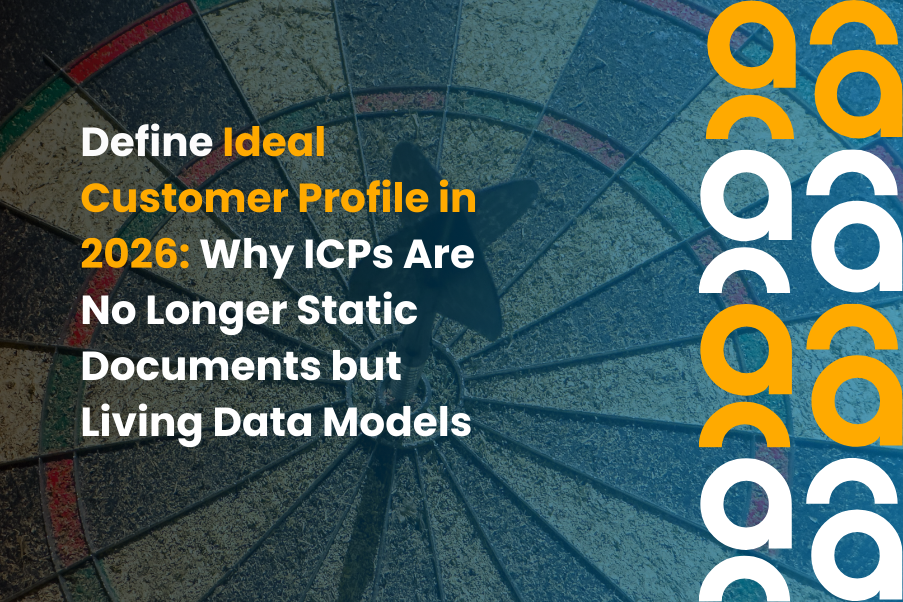 Define Ideal Customer Profile in 2026: Why ICPs Are No Longer Static Documents but Living Data Models
Define Ideal Customer Profile in 2026: Why ICPs Are No Longer Static Documents but Living Data Models -
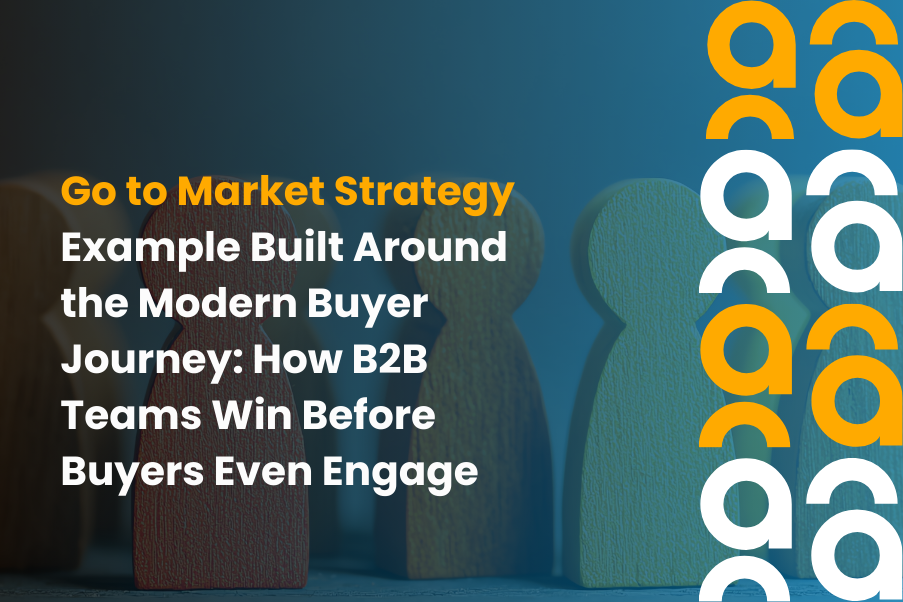 Go to Market Strategy Example Built Around the Modern Buyer Journey: How B2B Teams Win Before Buyers Even Engage
Go to Market Strategy Example Built Around the Modern Buyer Journey: How B2B Teams Win Before Buyers Even Engage -
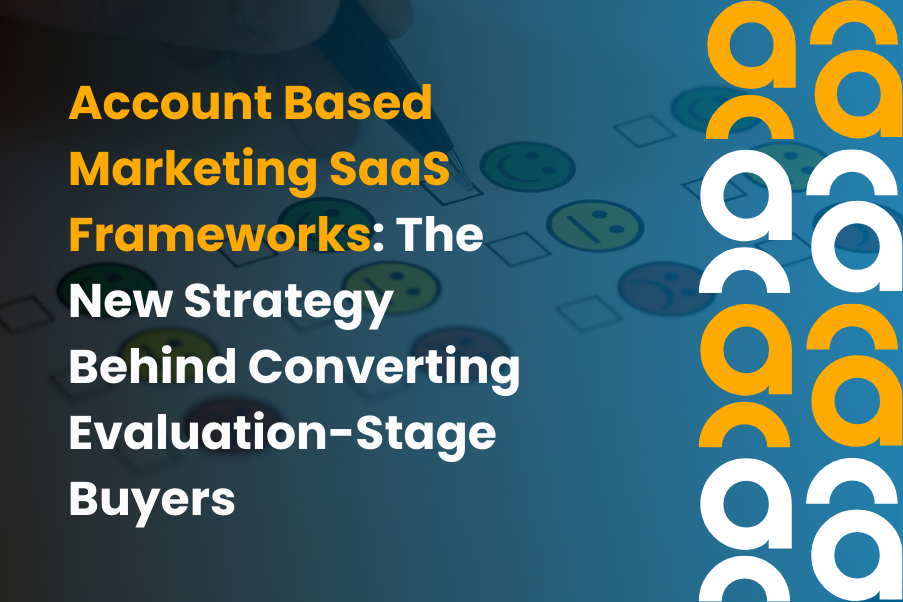 Account Based Marketing SaaS Frameworks: The New Strategy Behind Converting Evaluation-Stage Buyers
Account Based Marketing SaaS Frameworks: The New Strategy Behind Converting Evaluation-Stage Buyers -
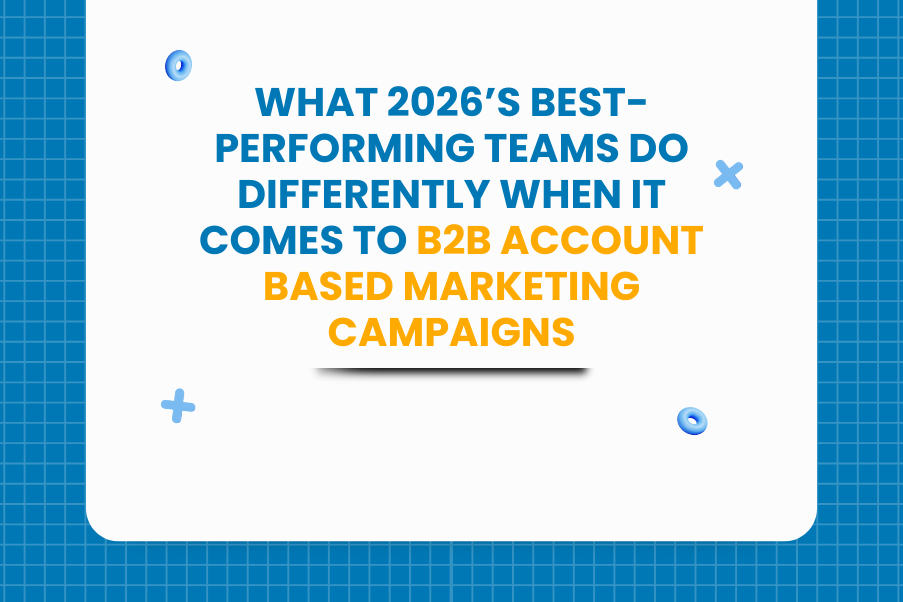 What 2026’s Best-Performing Teams Do Differently when it comes to B2B Account-Based Marketing Campaigns
What 2026’s Best-Performing Teams Do Differently when it comes to B2B Account-Based Marketing Campaigns -
 B2B Account Based Marketing in an Over-Messaged World: The Rise of Context-First Personalization
B2B Account Based Marketing in an Over-Messaged World: The Rise of Context-First Personalization

